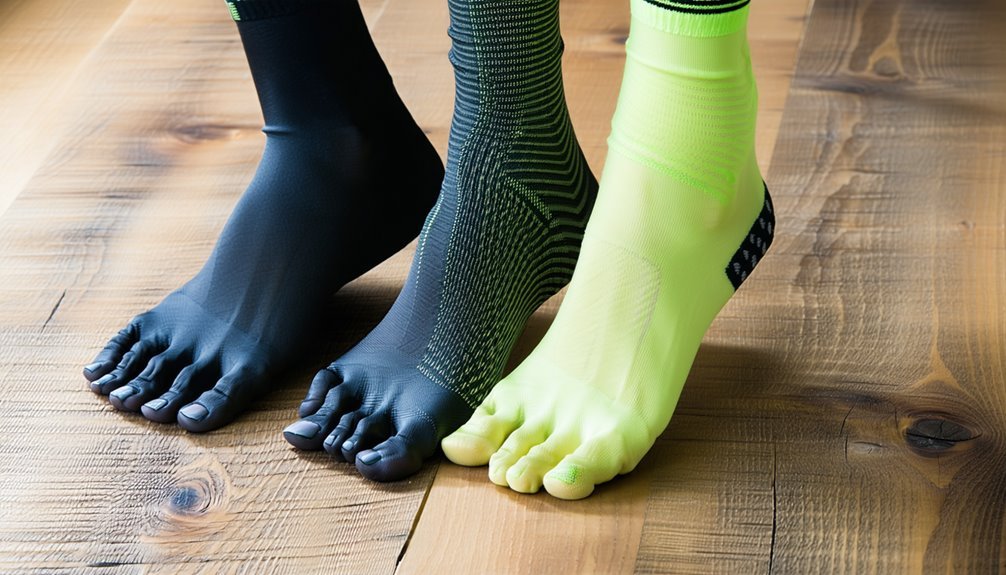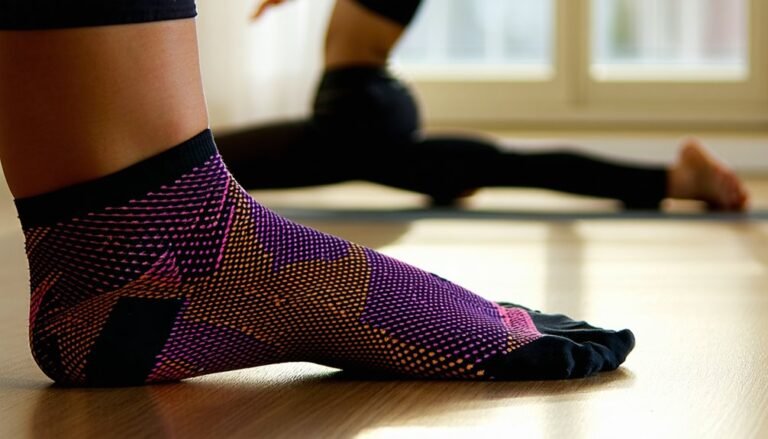Compression Sleeves Vs Socks
When choosing between compression sleeves and socks, focus on your anatomical needs and activity levels. Compression sleeves enhance muscle stability and circulation in the legs without covering the feet, ideal for athletes. Socks, applying graduated pressure, benefit lower extremities, aiding venous return and reducing swelling, especially during inactivity. Both options use breathable, moisture-wicking fabrics to maintain skin health. Pick based on intensity: sleeves for targeted muscle support, socks for whole-leg recovery. Access further insights to refine your choice.
Understanding Compression Technology

While compression technology may seem straightforward, its application is deeply rooted in anatomical and physiological principles. Understanding compression levels is vital for safely maximizing benefits. Compression sleeves and socks apply varied levels of pressure, typically measured in millimeters of mercury (mmHg). A proper compression level improves venous return without compromising arterial flow, ensuring safety and efficacy.
When considering fabric types, it is significant to highlight that they play a substantial role in functionality and comfort. Fabrics like nylon, spandex, and polyester are often used due to their elasticity and durability, providing consistent pressure distribution. These materials also offer breathability and moisture-wicking capabilities, essential for maintaining skin health. By focusing on these elements, you can make informed decisions about which compression products best suit your anatomical needs.
Benefits of Compression Sleeves
Understanding the role of fabric types and compression levels sets the stage for appreciating the benefits of compression sleeves. By enveloping your limbs, these sleeves promote better blood circulation, which is essential for reducing muscle fatigue and enhancing recovery. The compression sleeve benefits extend to providing stability to your muscles, reducing the risk of injuries like strains and sprains during athletic activities. Evidence suggests that wearing compression sleeves can lead to athletic performance enhancement by optimizing muscle efficiency and maintaining body temperature. Anatomically, they support venous return, aiding in the swift removal of metabolic waste from active muscles. Their design focuses on safety, ensuring that pressure is evenly distributed without compromising circulation, which is vital for both performance and recovery.
Advantages of Compression Socks
Compression socks, a staple in therapeutic and athletic settings, offer a unique set of advantages. Anatomically designed to apply graduated pressure, they enhance venous return and reduce leg swelling. The targeted compression supports the lower extremities, ensuring ideal blood flow back to the heart. Compression sock materials, such as nylon and spandex, provide durability while maintaining flexibility. You'll find various compression sock styles that cater to specific needs, whether you're an athlete or require medical-grade support. Wearing compression socks can minimize the risk of deep vein thrombosis (DVT) during prolonged periods of inactivity, such as long flights. They also alleviate discomfort from varicose veins, offering a safer, more comfortable experience. Trust in the science behind compression socks to prioritize your circulatory health.
Choosing the Right Compression for Your Activity
When deciding on compression gear, how do you determine the most suitable option for your specific activity? Consider the activity intensity and compression levels required. Higher-intensity activities may necessitate stronger compression to enhance circulation and reduce muscle fatigue. Conversely, lower-intensity activities might benefit from moderate compression, providing sufficient support without unnecessary constriction.
Here's a quick guide:
- Low Intensity: Choose lighter compression (15-20 mmHg) for walking or light yoga to guarantee gentle support.
- Moderate Intensity: Opt for medium compression (20-30 mmHg) for running or cycling to improve performance and recovery.
- High Intensity: Select strong compression (30-40 mmHg) for intense sports, aiding in injury prevention and muscle stabilization.
Always consider your specific anatomical needs and consult with a healthcare professional to guarantee safety.
Key Considerations for Fit and Comfort

Selecting the right compression for your activity is just one piece of the puzzle; ensuring a proper fit is equally essential for effectiveness and comfort. Begin by taking accurate fit measurements of your calf and ankle circumference for sleeves, and foot length for socks. Properly fitted compression gear supports venous return and reduces muscle fatigue. Ill-fitting options can cause discomfort or impair circulation, negatively impacting comfort levels.
Choose compression levels that cater to your specific needs, as tighter isn't always better. Graduated compression is typically recommended for promoting blood flow, with higher pressure at the ankle decreasing up the leg. Prioritize materials that offer breathability and moisture-wicking properties, ensuring prolonged wear doesn't compromise skin health. Comfort should never be sacrificed for compression benefits.
Tips for Maximizing Performance and Recovery
To maximize your performance and recovery with compression garments, guarantee you're choosing the proper fit, as it optimizes the garment's effectiveness in enhancing venous return and blood circulation. This improved circulation can lead to better oxygen delivery to your muscles, reducing fatigue and swelling. Additionally, compression aids in supporting muscle recovery by stabilizing muscle vibrations, which can minimize delayed onset muscle soreness.
Choosing Proper Fit
Achieving the ideal fit in compression sleeves and socks is essential for enhancing performance and expediting recovery. Proper fit guarantees maximum pressure on your muscles, improving support and reducing injury risk. Follow these steps for a precise fit:
- Size Measurement: Use a tape measure to determine the circumference of your calf or ankle. Compare it with the product's sizing chart to guarantee accuracy.
- Anatomical Focus: Choose compression gear that contours to your body's specific shape. Ill-fitting garments can compromise circulation and diminish benefits.
- Personal Preference: Some prefer a snug fit, while others might favor a looser feel. Balance comfort with compression effectiveness to enhance performance.
Enhancing Blood Circulation
Once you've secured the perfect fit, it's critical to focus on enhancing blood circulation to maximize performance and recovery. Compression sleeves and socks are designed to improve blood flow by exerting graduated pressure on your limbs. This pressure aids in pushing blood back toward the heart, optimizing venous health and reducing the risk of deep vein thrombosis. To achieve this, guarantee your compression gear maintains consistent pressure without constricting or causing discomfort. Avoid over-tightening, which can impede circulation rather than enhance it. Regularly monitor your skin for any signs of irritation or restricted blood flow, such as swelling or discoloration. By prioritizing proper usage, you'll experience improved oxygen delivery to muscles, promoting safer and more effective physical activity and recovery.
Supporting Muscle Recovery
Muscle recovery is vital for maintaining athletic performance and reducing injury risk. When selecting compression gear, consider how it aids in muscle fatigue reduction and optimizes recovery time. Compression sleeves and socks can both be effective, but choosing depends on specific needs.
- Targeted Support: Compression sleeves focus on specific muscle groups like calves or arms, providing localized support. This can be advantageous if you experience fatigue in particular areas.
- Full Lower Limb Coverage: Compression socks cover the entire foot and calf, offering uniform pressure that enhances venous return and reduces swelling. This can be significant for quicker recovery time post-exercise.
- Comfort and Fit: Confirm your compression gear fits snugly yet comfortably to prevent circulation issues.
Prioritize these factors to maximize safety and recovery efficiency.
Frequently Asked Questions
How Do Compression Sleeves and Socks Affect Blood Circulation?
You're considering how these garments enhance blood flow. Compression increases pressure on veins, aiding circulation improvement. This supports venous return, reducing clot risks. Proper usage guarantees safety, enhancing blood flow and promoting overall circulatory health.
Are There Any Potential Risks of Wearing Compression Gear Too Tightly?
Think of Achilles' heel; wearing compression gear too tightly increases injury risks. Excessive compression levels can constrict circulation, leading to numbness or tissue damage. Guarantee proper fit to maintain safety and promote healthy blood flow.
Can Compression Sleeves and Socks Help With Varicose Veins?
You're wondering if compression sleeves and socks can aid in varicose vein treatment. They're effective by enhancing circulation and reducing swelling. Guarantee proper fit for safety, as overly tight gear might compromise compression effectiveness and cause discomfort.
How Do I Wash and Care for Compression Garments?
Ever wonder how proper washing techniques affect fabric care? Hand wash with mild detergent and cold water to maintain elasticity. Avoid harsh chemicals and high heat. Proper care guarantees longevity, providing anatomical support and safety for your compression garments.
Are Compression Sleeves and Socks Suitable for Everyday Wear?
You can wear compression garments daily with proper fit ensuring anatomical support and improved circulation. They enhance daily comfort and offer various style options. Evidence shows they're safe for regular use, promoting vascular health without compromising safety.







